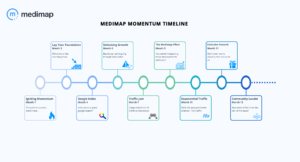- July 27, 2023
Share this article
Share on linkedin
Share on twitter
Share on facebook
Share on email
Harnessing the Power of Healthcare Content Marketing: How to Educate and Engage Patients
In the dynamic landscape of healthcare, content marketing has emerged as a powerful strategy for healthcare providers to connect with patients, educate them about health-related matters, and build lasting relationships. By creating valuable and informative content, clinics can position themselves as trusted sources of information and foster patient engagement. This blog will explore the benefits of content marketing for healthcare providers and showcase various types of content that clinics can create to educate patients effectively and build trust.
The Benefits of Content Marketing for Healthcare Providers
Content marketing goes beyond traditional advertising by focusing on providing valuable, relevant, and educational content to target audiences. For healthcare providers, content marketing offers several compelling benefits:
Establishing Thought Leadership:
By consistently sharing valuable insights and information, clinics can establish themselves as thought leaders in their respective fields. Thought leadership enhances the clinic’s reputation and builds trust among patients.Enhancing Patient Education:
Content marketing empowers clinics to educate patients about various health topics, medical conditions, treatment options, and preventive measures. Educated patients are more likely to make informed decisions about their health.Building Patient Trust:
Providing helpful and accurate information through content marketing fosters trust between clinics and patients. Trust is a crucial element in establishing long-term patient-provider relationships.Increasing Online Visibility:
High-quality content attracts and engages online audiences, leading to increased website traffic and improved search engine rankings. This, in turn, enhances the clinic’s online visibility and brand awareness.Driving Patient Engagement:
Engaging content encourages patients to interact with the clinic, ask questions, and share their experiences. This engagement strengthens patient loyalty and leads to positive word-of-mouth referrals.Types of Content to Educate Patients
To effectively educate and engage patients, healthcare providers can utilize a variety of content formats. Each format serves a specific purpose and caters to different patient preferences. Some effective content types include:
Blogs and Articles:
Informative blog posts and articles provide in-depth explanations of medical topics, treatment options, and health tips. They help patients understand complex information in a reader-friendly format. If you plan to incorporate blogs and articles into your strategy, keep the word count of each blog around 2500 words. According to Hubspot, articles with a word count between 2,250 and 2,500 earn the most organic traffic.Videos and Webinars:
Visual content, such as educational videos and webinars, captures patients’ attention and makes complex medical concepts more accessible. Videos can showcase procedures, offer expert insights, or feature patient testimonials.Infographics:
Infographics present information in a visually appealing and easy-to-understand manner. They condense complex data and statistics into bite-sized visuals that quickly communicate key messages.E-books and Guides:
Comprehensive e-books and guides offer in-depth knowledge on specific medical conditions, treatments, or wellness practices. Patients can download and access them at their convenience.Social Media Posts:
Short and engaging social media posts are perfect for quick health tips, inspirational quotes, or important updates. Social platforms enable clinics to interact with patients directly and share content efficiently.Crafting Compelling Healthcare Content
Creating compelling healthcare content requires a strategic approach. Here are some essential tips for crafting content that educates and engages patients:
Know Your Audience:
Understand the demographics and preferences of your target audience to tailor content that resonates with them.Focus on Patient Needs:
Address common patient concerns, questions, and pain points in your content. Providing solutions to patients’ problems demonstrates your clinic’s commitment to their well-being.Offer Accurate Information:
Ensure that all content is medically accurate and based on reputable sources. Misinformation can erode patient trust and damage the clinic’s credibility.Use Clear Language:
Avoid jargon and medical terminology that might confuse patients. Use plain language to communicate complex medical concepts in a more accessible manner.Tell Compelling Stories:
Patient success stories or testimonials can be incredibly powerful in illustrating the positive impact of your clinic’s services. Stories evoke emotions and create a personal connection with patients.Consistency is Key:
Maintain a consistent content schedule to keep patients engaged and demonstrate your clinic’s dedication to providing valuable information regularly.Promoting and Measuring Content Effectiveness
After creating valuable content, clinics must ensure that it reaches the intended audience and resonates with patients. Here are steps to promote and measure the effectiveness of healthcare content:
Leverage Email Marketing:
Send content directly to patients through newsletters or targeted email campaigns. Email marketing allows clinics to reach patients who have already expressed interest in their services.Share on Social Media:
Utilize social media platforms to promote content and engage with patients. Encourage patients to share content with their networks to expand the clinic’s reach.Track Engagement Metrics:
Monitor metrics such as website traffic, time spent on pages, and social media interactions to gauge content performance. Understanding which content resonates most with patients can inform future content creation.Patient Surveys:
Conduct surveys to gather feedback on content quality and relevance. Patient input can help clinics refine their content strategy and address patient needs more effectively.Conclusion
Harnessing the power of healthcare content marketing is a transformative strategy for healthcare providers to educate and engage patients actively. By creating valuable and informative content across various formats such as blogs, videos, infographics, and more, clinics can establish themselves as trusted sources of information.
Through content marketing, clinics can build patient trust, enhance patient education, increase online visibility, and foster patient engagement. By consistently offering valuable content that addresses patient needs and concerns, clinics can build lasting patient-provider relationships, promoting better health outcomes and a thriving healthcare community. Embrace the potential of content marketing to transform your clinic’s approach to patient education and establish a meaningful connection with your audience.
Patient testimonials can also play a role in boosting a clinic’s local search engine optimization efforts:
To easily search, compare and book an appointment with a health provider near you, visit medimap.ca.




